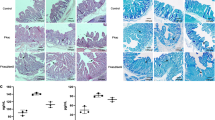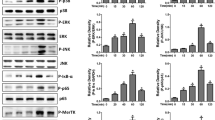Abstract
Apoptosis is a genetically regulated cellular suicide mechanism that plays an essential role in development and in defense of multicellular organism. Escherichia coli (E. coli) can induce monocyte apoptosis; however, the mechanism is not clear. This study determines if Fas/FasL regulates E. coli-induced human monocyte line U937 cell apoptosis. We found that infection of U937 cells with E. coli induced rapid cell death in a dose- and time-dependent manner displaying the characteristic features of apoptosis. Moreover, opsonized E. coli induced U937 apoptosis with a higher apoptotic rate (53.29 ± 5.83%) than non-opsonized E. coli (19.37 ± 2.56%). Studying the underlying mechanisms we found that the E. coli-induced apoptosis was associated with a more prominent induction expression of Fas/FasL in a time- and dose-dependent manner. Furthermore, E. coli treatment resulted in a significant increase in the levels of DR5, TRAIL, and FADD, but exerted no statistically significant effects on the levels of DR4. The activity of caspase-8 enzyme increased in infection groups, positively correlated with apoptosis rate. Taken together, these results clearly indicate that receptor-mediated phagocytosis of E. coli induces apoptosis. Moreover, our findings suggest a possible regulatory role of Fas/FasL in the pathway of E. coli infection.







Similar content being viewed by others

References
Meier P, Finch A, Evan G (2000) Apoptosis in development. Nature 407(6805):796–801
Agarwal R, Hassen S, Ali N (2010) Changes in cellular levels of inositol polyphosphates during apoptosis. Mol Cell Biochem 345(1–2):61–68
Yan B, Kong M, Chen YH (2011) Prevention of apoptosis by the interaction between FIH1 and Bax. Mol Cell Biochem 348(1–2):1–9
Perskvist N, Long M, Stendahl O, Zheng L (2002) Mycobacterium tuberculosis promotes apoptosis in human neutrophils by activating caspase-3 and altering expression of Bax/Bcl-XL via an oxygen-dependent pathway. J Immunol 168(12):6358–6365
Ribeiro-Gomes FL, Otero AC, Gomes NA, Moniz-De-Souza MC, Cysne-Finkelstein L, Arnholdt AC, Calich VL, Coutinho SG, Lopes MF, DosReis GA (2004) Macrophage interactions with neutrophils regulate Leishmania major infection. J Immunol 172(7):4454–4462
Wang JH, Zhou YJ, He P (2010) Staphylococcus aureus induces apoptosis of human monocytic U937 cells via NF-κB signaling pathways. Microb Pathog 49(5):252–259
Lucas A, Kim Y, Rivera-Pabon O, Chae S, Kim DH, Kim B (2010) Targeting the PI3K/Akt cell survival pathway to induce cell death of HIV-1 infected macrophages with alkylphospholipid compounds. PLoS ONE 5(9):e13121
Teng Y, Iuchi K, Iwasa E, Fujishiro S, Hamashima Y, Dodo K, Sodeoka M (2010) Unnatural enantiomer of chaetocin shows strong apoptosis-inducing activity through caspase-8/caspase-3 activation. Bioorg Med Chem Lett 20(17):5085–5088
Peng ZQ, Jiao N (2010) Influences of light and temperature on membrane potential and respiratory viability of an aerobic anoxygenic phototrophic bacterium Erythrobacter sp. JL475. Afr J Microbiol Res 4(10):964–968
Ahmed K, Zhao QL, Matsuya Y, Yu DY, Feril LB Jr, Nemoto H, Kondo T (2007) Rapid and transient intracellular oxidative stress due to novel macrosphelides trigger apoptosis via Fas/caspase-8-dependent pathway in human lymphoma U937 cells. Chem Biol Interact 170(2):86–99
Kim EJ, Park SY, Lee JY, Park JH (2010) Fucoidan present in brown algae induces apoptosis of human colon cancer cells. BMC Gastroenterol 10:96
Krammer PH (2000) CD95’s deadly mission in the immune system. Nature 407(6805):789–795
Casado-Zapico S, Martín V, García-Santos G, Rodríguez-Blanco J, Sánchez-Sánchez AM, Luño E, Suárez C, García-Pedrero JM, Menendez ST, Antolín I, Rodriguez C (2011) Regulation of the expression of death receptors and their ligands by melatonin in haematological cancer cell lines and in leukaemia cells from patients. J Pineal Res 50(3):345–355
Peter ME, Krammer PH (2003) The CD95(APO-A/Fas) DISC and beyond. Cell Death Differ 10(1):26–35
Naderi S, Blomhoff HK (2008) Activation of Camp signaling enhances Fas-mediated apoptosis and activation-induced cell death through potentiation of caspase 8 activation. Hum Immunol 69(12):833–836
Kotłowska-Kmieć A, Bakowska A, Szarszewski A, Kamińska B, Łuczak G, Radys W, Landowski P, Brodzicki J, Korzon M, Liberek A (2009) Helicobacter pylori increases expression of proapoptotic markers Fas and FasL on CD4 lymphocytes in children. Acta Biochim Pol 56(3):433–438
Zhou Z, Wu M, Barrett RP, McClellan SA, Zhang Y, Hazlett LD (2010) Role of the Fas pathway in Pseudomonas aeruginosa keratitis. Investig Ophthalmol Vis Sci 51(5):2537–2547
Chen M, Jahnukainen T, Bao W, Daré E, Ceccatelli S, Celsi G (2003) Uropathogenic Escherichia coli toxins induce caspase-independent apoptosis in renal proximal tubular cells via ERK signaling. Am J Nephrol 23(3):140–151
Jones NL, Islur A, Haq R, Mascarenhas M, Karmali MA, Perdue MH, Zanke BW, Sherman PM (2000) Escherichia coli Shiga toxins induce apoptosis in epithelial cells that is regulated by the Bcl-2 family. Am J Physiol Gastrointest Liver Physiol 278(5):G811–G819
Stravodimos KG, Singhal PC, Sharma S, Reddy K, Smith AD (1999) Escherichia coli promotes macrophage apoptosis. J Endourol 13(4):273–277
Wang JH, Zhou YJ, He P, Chen BY (2007) Roles of mitogen-activated protein kinase pathways during Escherichia coli-induced apoptosis in U937 cells. Apoptosis 12(2):375–385
Perskvist N, Zheng L, Stendahl O (2000) Activation of human neutrophils by mycobacterium tuberculosis H37Ra involves PLCγ2, Shc adapter protein and p38 MAPK. J Immunol 164(2):959–965
Ali F, Lee ME, Iannelli F, Pozzi G, Mitchell TJ, Read RC, Dockrell DH (2003) Streptococcus pneumoniae-associated human macrophage apoptosis after bacterial internalization via complement and Fcgamma receptors correlates with intracellular bacterial load. J Infect Dis 188(8):1119–1131
Aderem A, Underhill DM (1999) Mechanisms of phagocytosis in macrophages. Annu Rev Immunol 17:593–623
Evan G, Littlewood T (1998) A matter of life and cell death. Science 281(5381):1317–1322
May KL, Paton JC, Paton AW (2010) Escherichia coli subtilase cytotoxin induces apoptosis regulated by host Bcl-2 family proteins Bax/Bak. Infect Immun 78(11):4691–4696
Garibal J, Hollville E, Renouf B, Tétaud C, Wiels J (2010) Caspase-8-mediated cleavage of Bid and protein phosphatase 2A-mediated activation of Bax are necessary for Verotoxin-1-induced apoptosis in Burkitt’s lymphoma cells. Cell Signal 22(3):467–475
Fumarola C, Guidotti GG (2004) Stress-induced apoptosis: toward a symmetry with receptor mediated cell death. Apoptosis 9(1):77–82
Zheng SY, Li DC, Zhang ZD, Zhao J, Ge JF (2005) Adenovirus mediated FasL gene transfer into human gastric carcinoma. World J Gastroenterol 11(22):3446–3450
Xu B, Xu Z, Xia T, He P, Gao P, He W, Zhang M, Guo L, Niu Q, Wang A (2011) Effects of the Fas/Fas-L pathway on fluoride-induced apoptosis in SH-SY5Y cells. Environ Toxicol 26(1):86–92
Kitamura Y, Hashimoto S, Mizuta N, Kobayashi A, Kooguchi K, Fujiwara I, Nakajima H (2001) Fas/FasL-dependent apoptosis of alveolar cells after lipopolysaccharide-induced lung injury in mice. Am J Respir Crit Care Med 163((3 Pt 1)):762–769
Thornberry NA, Lazebnik Y (1998) Caspases: enemies within. Science 281(5381):1312–1316
Sun SY, Yue P, Wu GS, El-Deiry WS, Shroot B, Hong WK, Lotan R (1999) Implication of p53 in growth arrest and apoptosis induced by the synthetic retinoid CD437 in human lung cancer cells. Cancer Res 59(12):2829–2833
Acknowledgments
This study was supported by the Research Foundation Grant (L2010701) presented by Education Department of Liaoning province.
Author information
Authors and Affiliations
Corresponding author
Rights and permissions
About this article
Cite this article
Wang, JH., Peng, Y., Yang, LL. et al. Escherichia coli induces apoptosis in human monocytic U937 cells through the Fas/FasL signaling pathway. Mol Cell Biochem 358, 95–104 (2011). https://doi.org/10.1007/s11010-011-0925-z
Received:
Accepted:
Published:
Issue Date:
DOI: https://doi.org/10.1007/s11010-011-0925-z



